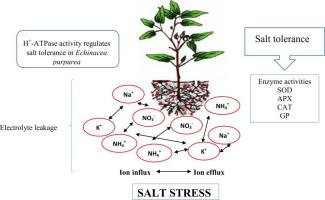Industrial Crops and Products ( IF 5.9 ) Pub Date : 2022-06-17 , DOI: 10.1016/j.indcrop.2022.115199 Fatemeh Ahmadi , Abbas Samadi , Ebrahim Sepehr , Amir Rahimi , Sergey Shabala

|
While the importance of biochemical processes in plant adaptive responses is widely accepted, only a limited number of studies have addressed cell-type specific and enzymatic activities in E. purpurea under salt stress conditions. So, various antioxidant enzymatic activities, H+ transport activity, and non-invasive ion flux mechanisms in the root apex and mature zones of E. purpurea grown at different NO3-/NH4+ ratios (90:10, 80:20, and 70:30) were studied in salinity stress condition (0, 15, 30, and 60 mM NaCl). Various parameters, photosynthetic and transpiration rates, gas exchange, ion accumulation, electrolyte leakage (EL) in addition to antioxidant enzyme activities and cell-specific mechanisms were measured according to the standard methods. Based on the results, 60 mM NaCl salinity stress significantly decomposed the cell membrane, causing to increase in the electrolyte leakage and malondialdehyde (MDA) content (89.4% compared with control) and a decrease in the photosynthetic rate (84% compared with control). The activity of antioxidant enzymes such as superoxide dismutase (SOD) and ascorbate peroxidase (APX), catalase (CAT), and glutathione peroxidase (GP) significantly increased up to 30 mM NaCl to diminish the free radicals content by increasing the hydrogen peroxide (H2O2) concentration (89.4% compared with control). High Na+ and Cl- content and their accumulation in the leaves caused to inhibit the antioxidants enzymes activities at 60 mM NaCl salinity stress. Based on the nitrogen (N) supply form, more antioxidant activities and physiological properties were found at the 90:10 NO3-/NH4+ ratio. Salinity stress is caused to limit the root apex growth in a high tissue- and treatment-specific manner. The differential sensitivity between the two zones originates from a 10-fold difference in K+ efflux and H+-ATPase activity between the mature zone and the apical region.
中文翻译:

细胞类型特异性 H+-ATP 酶活性和抗氧化酶提高紫锥菊 L. Moench 在不同 NO3-/NH4+ 比率下对盐胁迫的耐受性
虽然生化过程在植物适应性反应中的重要性已被广泛接受,但只有少数研究涉及盐胁迫条件下E. purpurea的细胞类型特异性和酶活性。因此,在不同 NO 3 - /NH 4 +比率(90:10、80 : 20、和 70:30)在盐度胁迫条件(0、15、30 和 60 mM NaCl)下进行研究。各种参数,光合作用和蒸腾作用根据标准方法测量速率、气体交换、离子积累、电解质泄漏 (EL) 以及抗氧化酶活性和细胞特异性机制。根据结果,60 mM NaCl盐分胁迫显着分解细胞膜,导致电解质泄漏和丙二醛(MDA)含量增加(与对照相比为89.4%),光合速率降低(与对照相比为84%) . 抗氧化酶如超氧化物歧化酶(SOD) 和抗坏血酸过氧化物酶(APX)、过氧化氢酶 (CAT) 和谷胱甘肽过氧化物酶 (GP) 的活性显着增加至 30 mM NaCl,通过增加过氧化氢 (H 2 O 2) 浓度(与对照相比为 89.4%)。高 Na +和 Cl -含量及其在叶片中的积累导致在 60 mM NaCl 盐分胁迫下抑制抗氧化剂酶的活性。根据氮 (N) 供应形式,在 90:10 NO 3 - /NH 4 +比例下发现了更多的抗氧化活性和生理特性。盐胁迫以高组织和治疗特异性方式限制根尖生长。两个区域之间的敏感性差异源于成熟区域和顶端区域之间K +流出和 H + -ATP 酶活性的 10 倍差异。


























 京公网安备 11010802027423号
京公网安备 11010802027423号